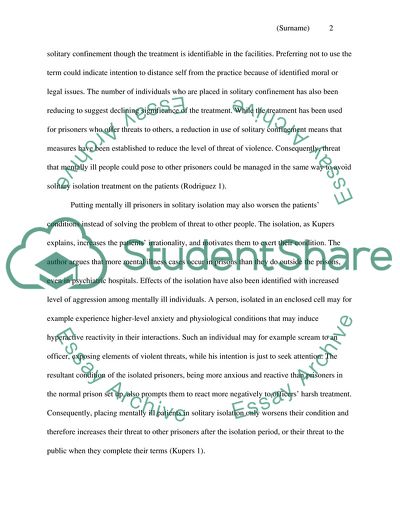Cite this document
(The Safety of Mentally Ill Prisoners in Solitary Confinement Essay Example | Topics and Well Written Essays - 1250 words - 1, n.d.)
The Safety of Mentally Ill Prisoners in Solitary Confinement Essay Example | Topics and Well Written Essays - 1250 words - 1. https://studentshare.org/psychology/1812217-why-it-is-safer-for-mentally-ill-prisoners-to-be-housed-in-solitary-confinement-rather-than-in-the-general-population
The Safety of Mentally Ill Prisoners in Solitary Confinement Essay Example | Topics and Well Written Essays - 1250 words - 1. https://studentshare.org/psychology/1812217-why-it-is-safer-for-mentally-ill-prisoners-to-be-housed-in-solitary-confinement-rather-than-in-the-general-population
(The Safety of Mentally Ill Prisoners in Solitary Confinement Essay Example | Topics and Well Written Essays - 1250 Words - 1)
The Safety of Mentally Ill Prisoners in Solitary Confinement Essay Example | Topics and Well Written Essays - 1250 Words - 1. https://studentshare.org/psychology/1812217-why-it-is-safer-for-mentally-ill-prisoners-to-be-housed-in-solitary-confinement-rather-than-in-the-general-population.
The Safety of Mentally Ill Prisoners in Solitary Confinement Essay Example | Topics and Well Written Essays - 1250 Words - 1. https://studentshare.org/psychology/1812217-why-it-is-safer-for-mentally-ill-prisoners-to-be-housed-in-solitary-confinement-rather-than-in-the-general-population.
“The Safety of Mentally Ill Prisoners in Solitary Confinement Essay Example | Topics and Well Written Essays - 1250 Words - 1”. https://studentshare.org/psychology/1812217-why-it-is-safer-for-mentally-ill-prisoners-to-be-housed-in-solitary-confinement-rather-than-in-the-general-population.


